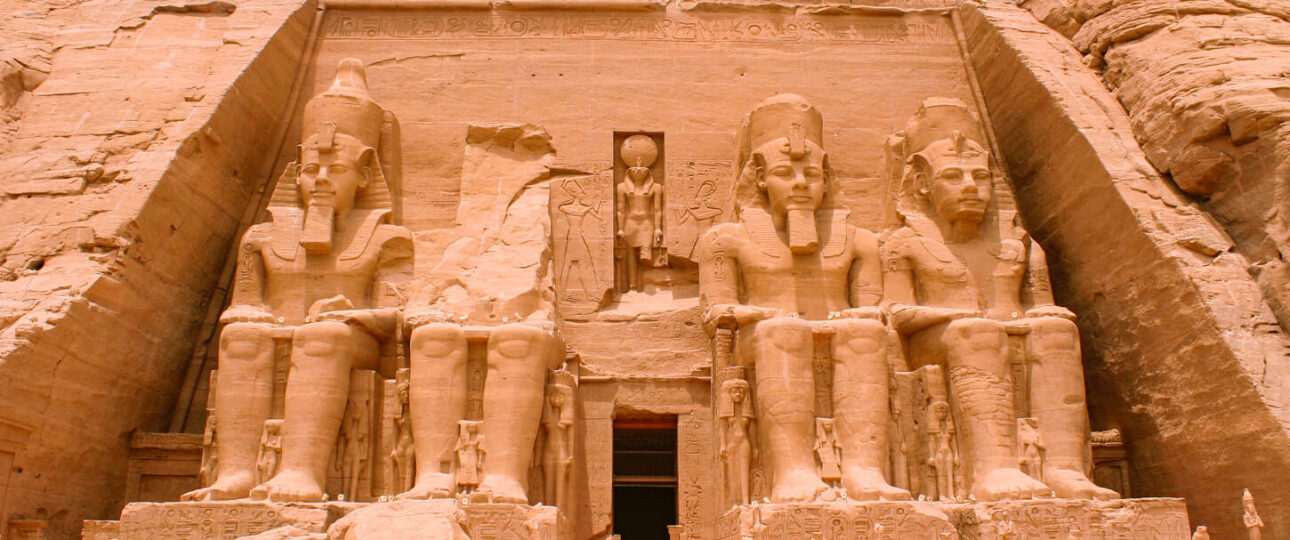Abu Simbel Temple: Exploring the Marvels of Ancient Egypt
Welcome to Abu Simbel Temple, an ancient Egyptian marvel that captivates travelers and history buffs. This magnificent temple complex along the Nile River shows the pharaohs’ grandeur and their skilled artisans’ engineering feats.
We’ll explore the temple’s history, significance, architectural marvels, and impressive relocation project that saved it from rising waters as we travel through time. Prepare to experience Abu Simbel Temple’s beauty and stone stories.
- Don’t miss out on our Best Time to Travel to Egypt
Abu Simbel Temple, A Testament to Ancient Egypt’s Glory
Step into the world of Abu Simbel Temple, where ancient Egypt’s rich history comes to life. Situated in the southern part of the country, near the present-day border with Sudan, this temple complex is an iconic UNESCO World Heritage Site that showcases the magnificence of the New Kingdom era.
The Abu Simbel Temple complex comprises two main temples, the Great Temple of Ramses II and the smaller Temple of Hathor and Nefertari. These temples were carved out of solid rock cliffs during the 13th century BCE, under the reign of Pharaoh Ramses II, also known as Ramses the Great. They were intended to commemorate Ramses II’s victory at the Battle of Kadesh and to honor the gods of ancient Egypt.
Exploring the Majestic Great Temple of Ramses II
The Great Temple of Ramses II, also known as the Temple of Abu Simbel, stands as an architectural masterpiece and a testament to Ramses II’s power and divine beliefs. This colossal temple features four seated statues of Ramses II at its entrance, each measuring a staggering 20 meters in height.
As you venture inside, you’ll be mesmerized by the intricately adorned walls and the colossal sculptures that depict scenes from Ramses II’s reign—the interior chambers house grand halls dedicated to various gods and goddesses, where rituals and offerings occur. The hypostyle hall, with its towering columns and vibrant colors, is a sight.
The Temple of Hathor and Nefertari, A Marvel of Beauty and Love
Adjacent to the Great Temple stands the smaller yet equally captivating Temple of Hathor and Nefertari. This temple was dedicated to Hathor, the goddess of love and joy, and Nefertari, Ramses II’s beloved wife. The exterior facade of the temple features six statues, four depicting Ramses II and two representing Nefertari.
Inside, the walls depict scenes of Ramses II and Nefertari making offerings to the gods, accompanied by intricate hieroglyphic inscriptions. The sanctuaries within the temple house statues of Hathor and Nefertari, inviting visitors to experience the sacred atmosphere and pay homage to the deities.
The Miraculous Relocation Project, Saving Abu Simbel Temple
In the 1960s, the construction of the Aswan High Dam posed a threat to Abu Simbel Temple. The rising waters of Lake Nasser, the dam’s reservoir, would have submerged this precious treasure beneath its depths. To preserve this ancient wonder, an ambitious relocation project was undertaken.
Led by UNESCO, the relocation project involved carefully dismantling both temples and relocating them to higher ground, ensuring their protection for future generations. This colossal effort required meticulous planning, engineering expertise, and the dedication of countless individuals who recognized the importance of safeguarding Abu Simbel Temple’s cultural heritage.
about Abu Simbel Temple
How long did it take to relocate to Abu Simbel Temple?
The relocation process of Abu Simbel Temple took approximately four years to complete. It commenced in 1964 and concluded in 1968.
How was the relocation of Abu Simbel Temple accomplished?
The relocation involved cutting the temples into massive blocks weighing up to 30 tons. These blocks were then carefully transported and reassembled at a higher location, away from the encroaching waters.
What is the significance of the Abu Simbel Temple?
Abu Simbel Temple holds immense historical and cultural significance. It showcases the architectural prowess of ancient Egypt and serves as a testament to Ramses II’s reign and the gods worshiped during that era.
Can visitors enter the interiors of the temples?
Yes, visitors can explore the interiors of the Great Temple of Ramses II and the Temple of Hathor and Nefertari. However, photography may be restricted in certain areas to preserve the delicate ancient artwork.
Is Abu Simbel Temple easily accessible to tourists?
While Abu Simbel Temple is located in a relatively remote part of Egypt, it is accessible by road and air. Various tour operators and transportation services are available to facilitate visits to this awe-inspiring site.
Are there any other notable attractions near Abu Simbel Temple?
Yes, in addition to Abu Simbel Temple, visitors can explore other remarkable sites in the vicinity, such as the temples of Philae and Kom Ombo, the Nubian Museum, and the vibrant markets of Aswan.
- Also Read Our Landmarks in Egypt
Conclusion
Abu Simbel Temple exemplifies ancient Egypt’s grandeur and ingenuity. This impressive temple complex amazes visitors with its massive statues, intricately decorated walls, and remarkable relocation project.
Let the tales of pharaohs and gods take you back in time as you admire the grand architecture, exquisite artwork, and rich history. Abu Simbel Temple invites you into ancient Egypt’s mysteries and wonders.
So visit Abu Simbel Temple, where history is everywhere. Enjoy the majesty and timeless allure of this ancient wonder.

